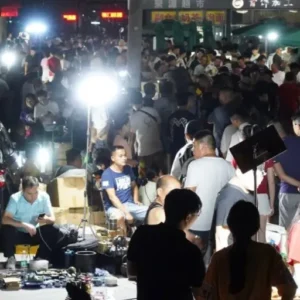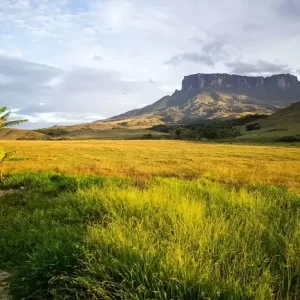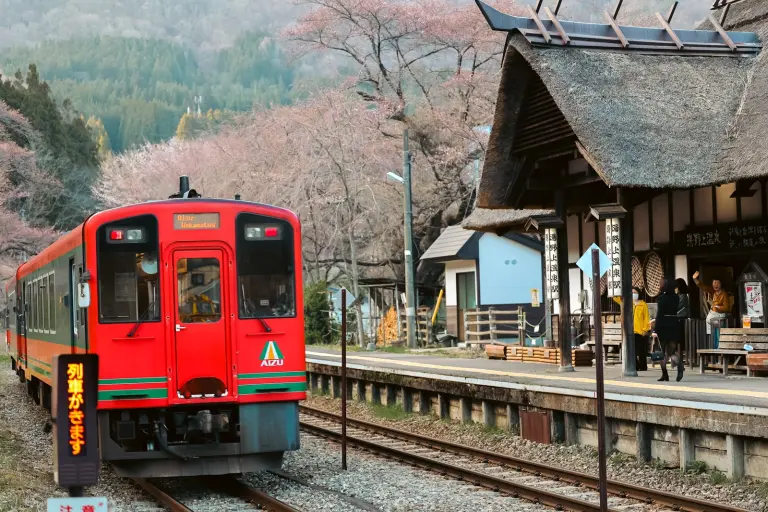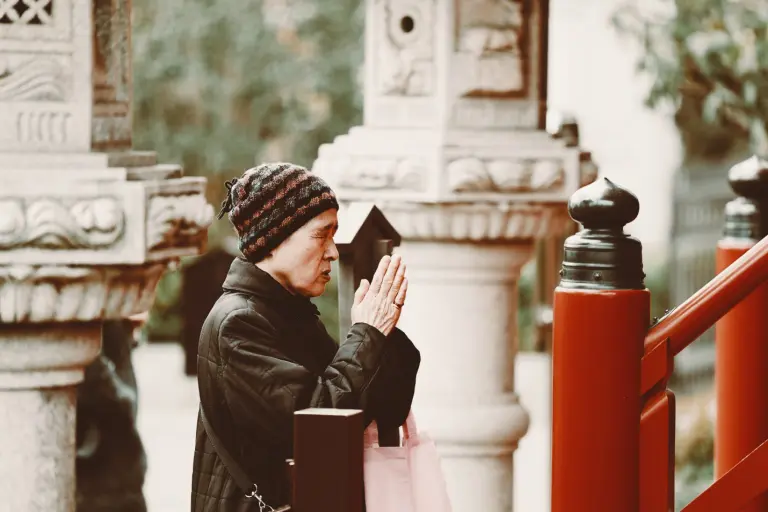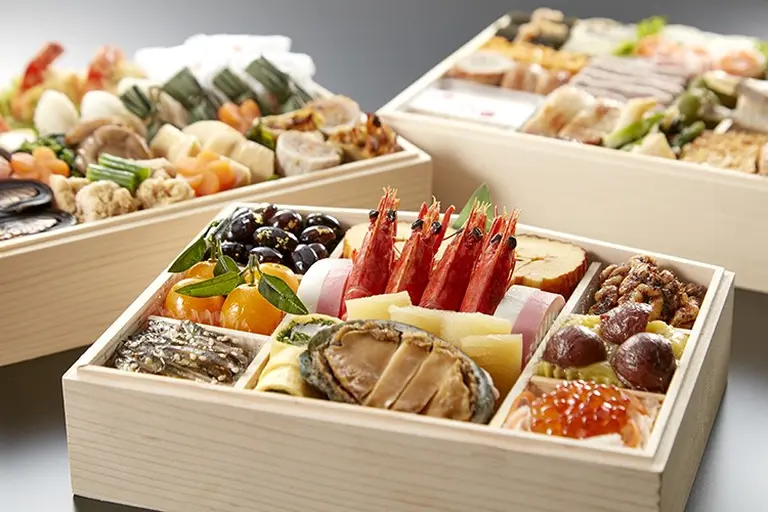Rinpung Dzong is the most famous monastery in Bhutan. Today, it functions as a government office, housing the Paro Court of Justice and the seat of the local religious body.
History of Rinpung Dzong
In the 15th century, locals requested the establishment of a place to study Buddhist teachings. Lama Drung Drung Gyal, a descendant of Pajo Drugom Zhigpo, built a small temple here. Over time, the site became known as Hungrel Monastery or Hungrel Dzong.
By the 17th century, the descendants of Drung Drung Gyal integrated the site into the Drukpa system under Ngawang Namgyal and Zhabdrung Rinpoche, recognizing its religious authority. In 1644, Zhabdrung dismantled the old structure and laid the foundation for a new dzong. Shortly after, Rinpung Dzong was constructed. Once completed, it became one of the most important administrative centers in Western Bhutan.
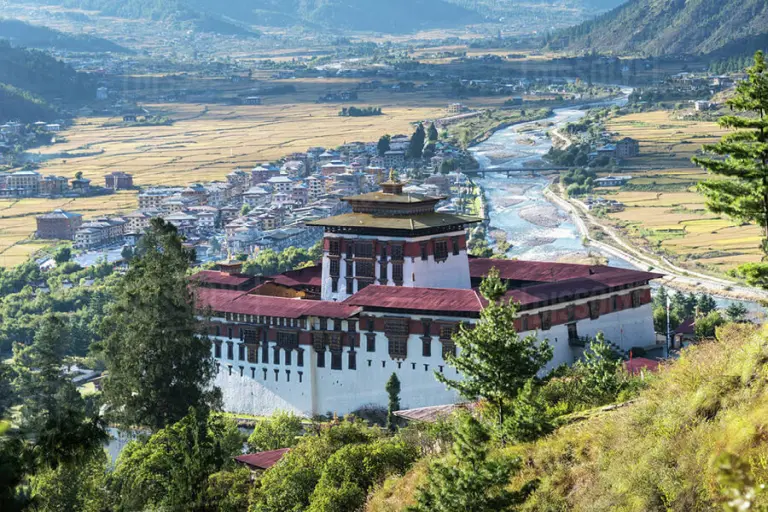
>> Traveling to Bhutan: What you need to know
Exploring Rinpung Dzong
Rinpung Dzong, also known as Paro Dzong, is a striking example of Bhutanese architecture and spirituality. At night, the fortress is beautifully illuminated, and inside, visitors can find vivid murals depicting the life of the Buddha.
A walk up to the dzong rewards travelers with spectacular views of the surrounding valleys. The monastery also hosts the vibrant Paro Tshechu Festival each year, making the site even more remarkable.
Located in the heart of Paro town, Rinpung Dzong remains a place of faith, beauty, and cultural pride. Beyond its religious importance, the dzong offers panoramic views of the Paro Valley and Paro Chhu River. Like most dzongs in Bhutan, it houses both monks and administrative offices.
It was also featured in the 1995 film Little Buddha, and today it remains a favorite family-friendly destination, where its serene atmosphere makes every evening more joyful and memorable.
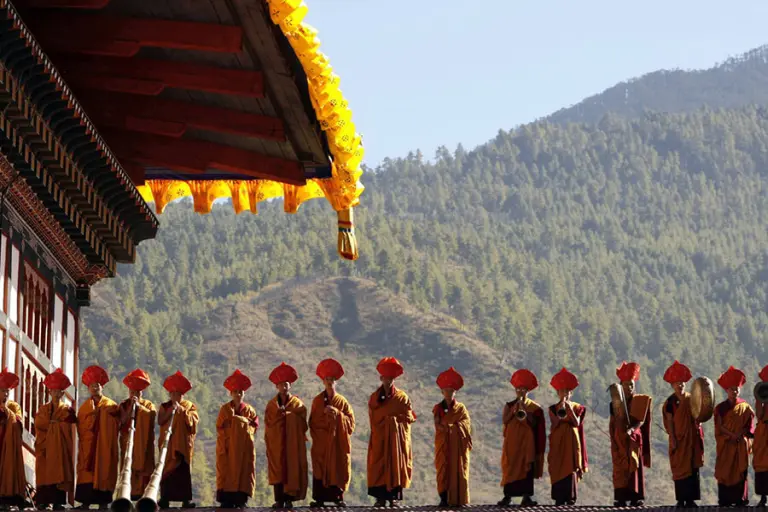
Architecture of Rinpung Dzong
Paro Dzong is one of the largest and finest examples of Bhutanese dzong architecture. It is home to ancient Buddhist relics, chapels, and exquisite wooden carvings.
- The Watchtower (Ta Dzong): Originally built in 1649 as a seven-story fortress tower, later renovated in 1968 to house the National Museum of Bhutan.
- Chapels & Shrines: Inside the dzong are 14 temples and shrines dedicated to various deities. These are not open to the general public.
- Bridge: At the foot of the dzong lies a charming wooden cantilever bridge, beloved by visitors.
Like other traditional Bhutanese structures, the dzong was constructed without the use of nails or steel. Its central tower, the Utse, rises five stories high, decorated with religious paintings and carvings.
The courtyard outside hosts Paro Tshechu, one of Bhutan’s most famous festivals, lasting four days. On the final day, a giant silk thangka of Guru Rinpoche is unfurled on the dzong’s walls. The murals within the dzong are masterpieces—each narrating sacred stories, making it a true paradise for art lovers.
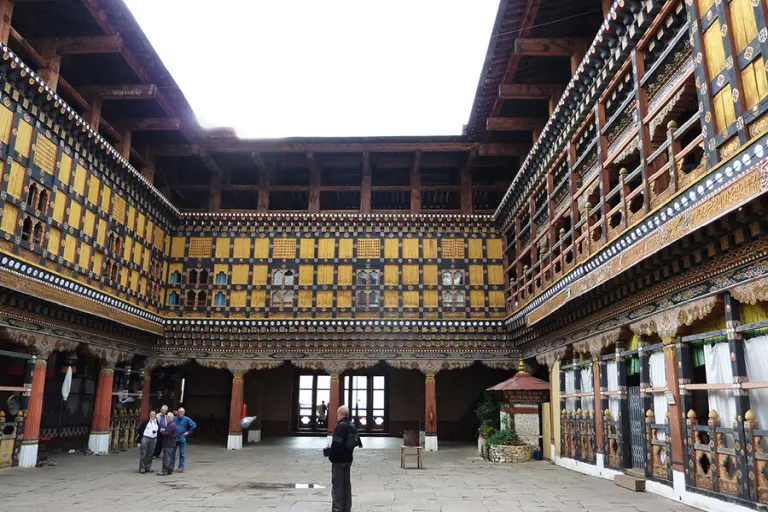
>> What to know before visiting Bhutan – Dos & Don’ts
Cultural Significance of Rinpung Dzong
Rinpung Dzong literally means “Fortress of the Heap of Jewels.”
Before its current form, a small temple was established here in the 15th century by Lama Drung Drung Gyal. Later expanded into Hungrel Dzong, it was eventually rebuilt by Ngawang Namgyal in 1644 as Rinpung Dzong.
Historically, the dzong served as a safe refuge for locals during Tibetan invasions and functioned as a defensive fortress. It was also once the meeting hall of Bhutan’s National Assembly before becoming the administrative headquarters of Paro.
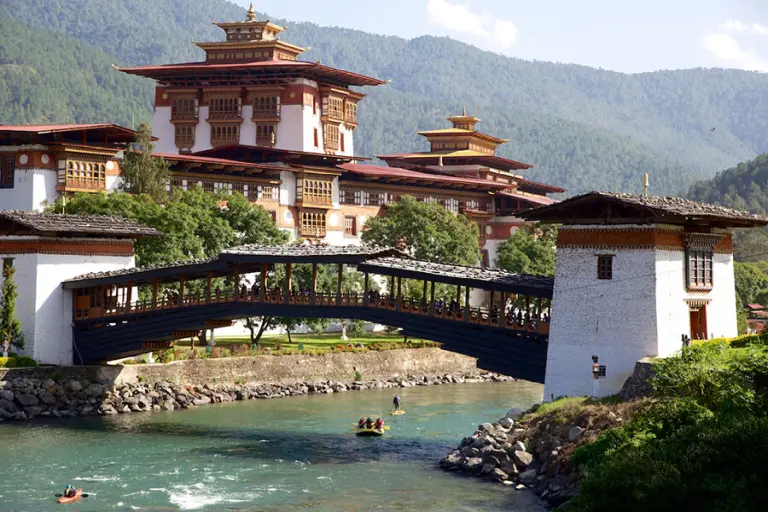
Festivals & Traditions
Visiting Bhutan in March–April offers the chance to witness the Paro Tshechu Festival, a grand Buddhist celebration lasting 11–15 days.
During the festival, Bhutanese people gather to:
- Watch sacred religious dances performed by monks in elaborate masks and costumes.
- Admire giant religious thangkas and spiritual paintings.
- Celebrate Bhutanese values of compassion, honesty, and spiritual devotion.
This cultural experience makes Rinpung Dzong not only a historic site but also a living center of Bhutanese tradition.
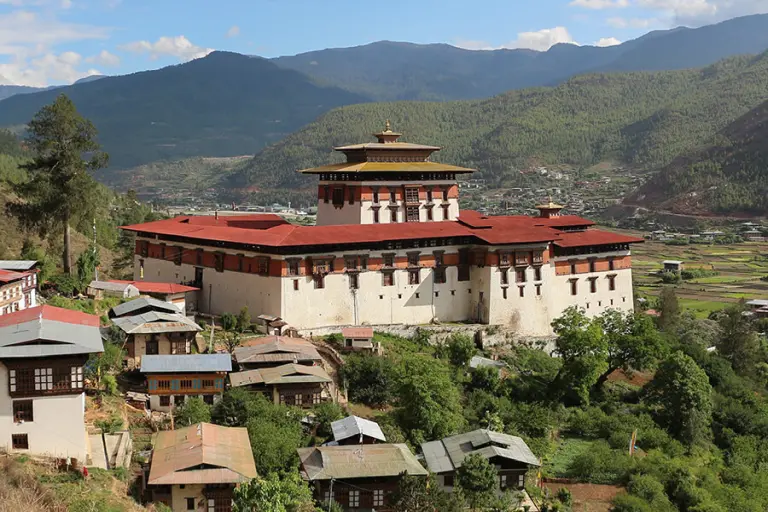
>> The people of Bhutan – 7 fascinating facts about the happiest residents on earth
How to Get to Rinpung Dzong
- By Taxi: Visitors can easily hire a taxi from major attractions or hotels in Paro.
- With a Guide: Most tour operators in Bhutan include Rinpung Dzong in their itineraries.
Right outside Paro Dzong is the Degyankha Temple, considered equally sacred. The traditional wooden cantilever bridge over the Paro Chhu also provides breathtaking views, making the journey to the dzong as memorable as the destination itself.
Rinpung Dzong is more than a fortress—it is a symbol of Bhutan’s cultural and spiritual heritage. With its stunning architecture, deep history, and colorful festivals, this monastery remains one of the most unforgettable places to visit in Bhutan.
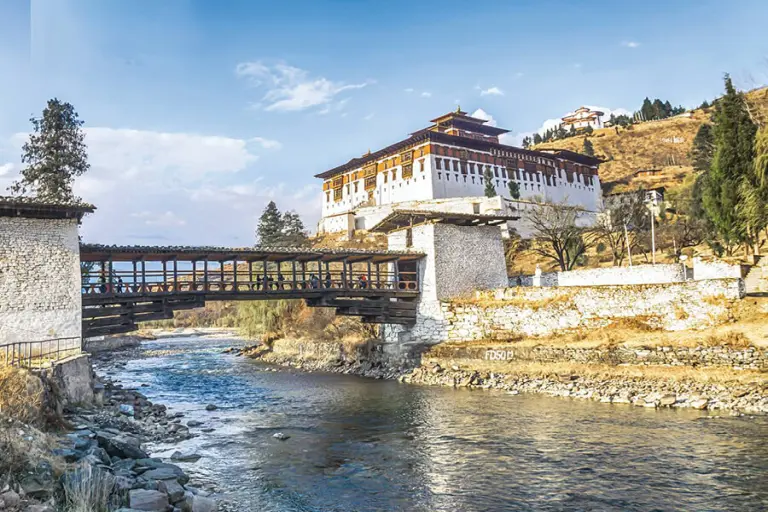
>> Dzongkha – The language of happiness in Bhutan
FAQ
What is Rinpung Dzong?
Rinpung Dzong, meaning “Fortress of the Heap of Jewels,” is one of Bhutan’s most iconic dzongs. Located in the Paro Valley, it is a striking example of Bhutanese fortress-monastery architecture, with towering whitewashed walls, red ochre bands, intricate woodwork, and sweeping views of the Paro Chhu River. Beyond its beauty, Rinpung Dzong serves both religious and administrative functions, housing the monastic body of Paro as well as district government offices.
Why is Rinpung Dzong historically significant?
Built in the 16th century by Ngawang Namgyal, the unifier of Bhutan, Rinpung Dzong has played a crucial role in Bhutan’s defense and religion. It has withstood invasions from Tibet and continues to be a hub of Buddhist practice. The dzong also houses many sacred relics and murals, some dating back hundreds of years, offering a glimpse into Bhutan’s artistic and spiritual legacy.
What makes Rinpung Dzong unique compared to other monasteries?
Unlike many monasteries perched high on remote mountains, Rinpung Dzong stands gracefully above the Paro River, accessible yet majestic. It is particularly famous for its wooden cantilever bridge (Nyamai Zam), one of the most beautiful traditional bridges in Bhutan. Its massive walls glow golden in the evening sun, making it a picture-perfect landmark of Paro.
Can tourists visit Rinpung Dzong?
Yes, visitors are welcome. You can walk through its courtyards, admire its temples, and see the intricate murals depicting Buddhist stories and protective deities. However, note that some areas are restricted, as it still functions as a monastery and government office. A modest dress code is required (long pants, covered shoulders), and shoes must be removed before entering temples.
What festivals are celebrated at Rinpung Dzong?
The most famous is the Paro Tshechu, held every spring. This vibrant festival includes sacred mask dances (cham), colorful traditional attire, and rituals that reenact stories from Buddhist teachings. On the final day, a giant thangka (religious tapestry) known as a thongdrol is unfurled before sunrise, believed to bless all who see it. Visiting during this time offers an unforgettable cultural experience.
When is the best time to visit Rinpung Dzong?
The best time is during the Paro Tshechu (March or April), when the dzong comes alive with music, dance, and devotion. Outside of festival season, spring (March–May) and autumn (September–November) are the most pleasant times to explore, with clear skies and stunning valley views.
How do you get to Rinpung Dzong?
Rinpung Dzong is located in Paro, just a short drive from Paro International Airport. Many travelers stop here on their way to or from Taktsang Monastery (Tiger’s Nest), as both are must-see attractions in the valley. The approach via the traditional wooden bridge makes for a particularly scenic entrance.
What should travelers know before visiting Rinpung Dzong?
- Respect the sacredness: This is an active monastery and office, so maintain quiet and respect.
- Photography: Photos are usually allowed in the courtyards but not inside temples.
- Guides: Hiring a local guide will help you understand the symbolism in the murals and architecture.
- Best time: Arrive in the late afternoon to see the dzong glowing in the golden light of sunset.
Rinpung Dzong isn’t just a fortress — it’s a living heritage site where Bhutan’s history, spirituality, and artistry merge beautifully. A visit here offers travelers not only breathtaking views but also a deep connection to Bhutanese culture.
>> Unique cultural traits of the land of the Thunder Dragon, Bhutan


